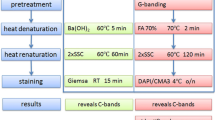Abstract
By controlling the degree of chromatin denaturation through formamide incubation, or by heat treatment and/or by high pH, three types of high quality 4′,6-diamidino-2-phenylindole (DAPI) bands can be produced sequentially on the same set of 5-bromo-2′-deoxyuridine (BrdU)-incorporated chromosomes: first DAPI multibanding (the equivalent of Q-banding), then partial C-banding including distamycin A (DA)/DAPI banding, and finally C-banding pattern. It is assumed that the different DAPI-chromatin interactions following these treatments reflect the different chromatin structures at the chromosomal sites. Since the DAPI banding protocol is compatible with in situ hybridization, the combination of fluorescent in situ hybridization (FISH) with DAPI banding allows the simultaneous detection of signals from the DNA probes and the identification of the chromosomal band location of the probe. We demonstrate this useful application with the localization of the cystic fibrosis and Duchenne muscular dystrophy gene probes to their appropriate bands.
Similar content being viewed by others
References
Bhatt B, Burns J, Flannery D, McGee JO (1988) Direct visualization of single copy genes on banded metaphase chromosomes by nonisotopic in situ hybridization. Nucleic Acids Res 16: 3951–3961
Boyle AL, Ballard SG, Ward DC (1990) Differential distribution of long and short interspersed element sequences in the mouse genome: Chromosome karyotyping by fluorescence in situ hybridization. Proc Natl Acad Sci USA 87: 7757–7761
Boyle AL, Ffltquite DM, Dracopoli N, Housman DE, Ward DC (1992) Rapid physical mapping of cloned DNA on banded mouse chromosomes by fluorescence in situ hybridization. Genomics 12: 106–115
Duncan AMV, Buchwald M, Tsui LC (1988) In situ hybridization of two cloned chromosome 7 sequences tightly linked to the cystic fibrosis locus. Cytogenet Cell Genet 49: 309–310
Dworzak M, Stock C, Strehl S, Gadner H, Ambros PF (1992) Ewing's tumour x mouse hybrids expressing the MIC2 antigen: analysis using fluorescence CDD-banding and non-isotopic ISH. Hum Genet 88: 273–278
Fan YS, Davis LM, Shows TB (1990) Mapping small DNA sequences by fluorescence in situ hybridization directly on banded metaphase chromosomes. Proc Natl Acad Sci USA 87: 6223–6227
Gillard EF, Chamberlain MEG, Duff CL, Smith B, Burghes AHM, Thompson MW, Sutherland J, Oss I, Bodrug SE, Klamut HJ, Ray PN, Worton RG (1989) Molecular and phenotypic analysis of patients with deletions within the deletion-rich region of the Duchenne muscular dystrophy (DMD) gene. Am J Hum Genet 45: 507–520
Grady DL, Ratliff RL, Robinson DL, McCanlies EC, Meyne J, Moyzis RK (1992) Highly conserved repetitive sequences are present at human centromeres. Proc Natl Acad Sci USA 89: 1695–1699
Hajduk SL (1976) Demonstration of kinetoplast DNA in dyskinetoplastic strains ofTrypanosoma equiperdum. Science 191: 858–859
Heng HQ, Chen WY, Wang YC (1988) Effects of pingyanmycin on chromosomes: A possible structural basis for chromosome aberration. Mutat Res 199: 199–205
Heng HQH, Squire J, Tsui LC (1992) High resolution mapping of mammalian genes by in situ hybridization to free chromatin. Proc Natl Acad Sci USA 89: 9509–9513
Kapuscinski J, Szer W (1979) Interaction of 4′, 6-diamidine-2-phenylindole with synthetic polynucleotides. Nucleic Acids Res 6: 3519–3534
Klever M, Grond-Ginshach C, Scherthan H, Schroeder-Kurth TM (1991) Chromosomal in situ suppression hybridization after Giemsa banding. Hum Genet 86: 484–486
Korenberg JR, Rykowski MC (1988) Human genome organization: Alu, Lines and the molecular structure of metaphase chromosome bands. Cell 53: 391–400
Lichter P, Tang CJC, Gall K, Hermanson G, Evans G, Housman D, Ward DC (1990) High-resolution mapping of human chromosome 11 by in situ hybridization with cosmid clones. Science 247: 64–69
Lichter P, Boyle A, Cermer T, Ward D (1991) Analysis of gene and chromosome by non-isotopic in situ hybridization. GATA 8: 24–35
Lin MS, Comings DE, Alfi OS (1977) Optical studies of the interaction of 4′-6-diamidino-2-phenylindole with DNA and metaphase chromosomes. Chromosoma 60: 15–25
Moyzis RK, Albright KL, Bartholdi MF, Cram LS, Deaven LL, Hildebrand CE, Joste NE, Longmire JL, Schwarzacher-Robinson T (1987) Human chromosome specific repetitive DNA sequences: Novel markers for genetic analysis. Chromosoma 95: 375–386
Puckett C, Gomez CM, Korenberg JR, Tung H, Meier TJ, Chen XN, Hood L (1991) Molecular cloning and chromosomal localization of one of the human glutamate receptor genes. Proc Natl Acad Sci USA 88: 7557–7561
Rommens J, Iannuzzi MC, Kerems BS, Drumm ML, Melmer G, Dean M, Rozmahel R, Cole JL, Kennedy D, Hidaka N, Zsiga M, Buchenwald M, Riordan JR, Tsui LC, Collins FS (1989) Identification of the cystic fibrosis gene: chromosome walking and jumping. Science 245: 1059–1065
Schwarzacher-Robinson T, Cram LS, Meyne J, Moyzis RK (1988) Characterization of human heterochromatin by in situ hybridization with satellite DNA clones. Cytogenet Cell Genet 47: 192–196
Schweizer D (1976) Reverse fluorescent chromosome banding with chromomycin and DAPI. Chromosoma 58: 307–324
Schweizer D (1983) Distamycin-DAPI bands: properties and occurrence in species. In: Brandham PE, Bennett MD (eds) Kew Chromosome Conference II. HMSO, pp 43–51
Schweizer D, Nagl W (1976) Heterochromatin diversity inCybidium and its relationship to different DNA replication. Exp Cell Res 98: 411–423
Schweizer D, Ambros P, Andrle M (1978) Modification of DAPI banding on human chromosomes by prestaining with a DNA-binding oligopeptide antibiotic, distamycin A. Exp Cell Res 111: 327–332
Tsui LC, Estivill X (1991) Identification of disease genes on the basis of chromosomal location. In: Davies KE, Tilghman S (eds) Genome analysis, vol 3: genes and phenotype. Cold Spring Harbor Laboratory Press, Cold Spring Harbor, NY, pp 1–36
Author information
Authors and Affiliations
Additional information
Communicated by: P.B. Moens
Rights and permissions
About this article
Cite this article
Heng, H.H.Q., Tsui, LC. Modes of DAPI banding and simultaneous in situ hybridization. Chromosoma 102, 325–332 (1993). https://doi.org/10.1007/BF00661275
Received:
Revised:
Accepted:
Issue Date:
DOI: https://doi.org/10.1007/BF00661275




